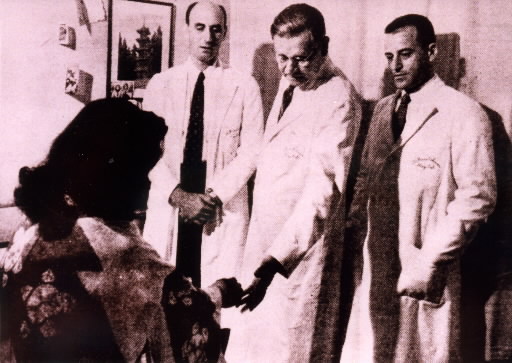Hiroshima Girls, Part 2: Bridging Japan and the United States [3]
Jul. 3, 2010
Treatment provided in former enemy country
by Masami Nishimoto, Staff Writer
This feature series on the "Hiroshima Girls," also known as "Hiroshima Maidens," is a close look at a number of Japanese women who were impacted by the atomic bombing of Hiroshima. The series was originally published in 1996.
The project to provide medical treatment to the "Hiroshima Girls" in the United States was the brainchild of Rev. Kiyoshi Tanimoto and was made possible by Norman Cousins. In April 1955, a screening of candidates was conducted at Hiroshima City Hospital.
Out of 37 people who undertook a preliminary examination, 25 single women were selected. Their conditions and physical vigor promised some degree of positive outcome if they underwent plastic surgery. The oldest of the group was 31.
Looking through the records of examination by both Japanese and American doctors and newspaper articles reporting the selection results, a comment by the then head of the city's welfare division draws attention: "There are some criticisms, but we would like to accept their goodwill with genuine gratitude." Some people in Hiroshima felt cool toward the treatment project in the United States.
To that point, survivors of the atomic bombing had been treated as mere objects of research by the Atomic Bomb Casualty Commission (ABCC), an American organization. Because of bitterness toward the former enemy nation, along with feelings of opposition toward the ABCC, not a few people voiced suspicion over the aims and results of medical treatment in the United States, which had dropped the atomic bomb.
Dr. Tomin Harada, 84, a resident of Naka Ward, Hiroshima, took part in the selection process as one of the committee members of the Hiroshima Atomic Bomb Casualty Council. He had reservations when he was asked to accompany the survivors to the United States for treatment.
Facing a difficult decision, he sought advice from Arata Osada, professor emeritus at Hiroshima University and the editor of "Children of the Atomic Bomb," a collection of A-bomb experiences written by children. Mr. Osada told Dr. Harada, "To the good will of American citizens, who are trying to express their conscience and atonement, we should respond with good will." These words encouraged Dr. Harada to join the project. [Arata Osada died in 1961 at the age of 75.]
One month after the selection, a group of 35 people, including those accompanying the survivors, offered prayers before the Cenotaph for the A-bomb Victims and departed for the United States from the U.S. Air Station in Iwakuni, Yamaguchi Prefecture. Mr. Cousins had asked the U.S. Air Force to provide the flight overseas. With stops, it took five days for them to reach Mitchel Air Force Base in the suburbs of New York. The survivors, never seen by the American public before, were trailed by the cameras of newspapers and TV stations.
Glenn Everett, a 75-year-old resident of Washington and a long-time reporter for a religious newspaper, recalled that there were attempts within the government to block the effort, which some claimed was a plot by communists. He met the young women on their arrival as a director of the U.S. Hiroshima Peace Center Association, which was in charge of the treatment program.
Against the backdrop of the Cold War with the former Soviet Union, the U.S. had begun hydrogen bomb experiments three years earlier. The government was afraid that coverage of the A-bomb survivors would prompt the spread of opposition to its development of atomic and hydrogen bombs. The State Department went so far as to send a telegraph to Japan, seeking to cancel the flight of the U.S. plane C54 arranged for transportation.
The women were admitted to Mount Sinai Hospital, founded by a Jewish American. (Norman Cousins was also of Jewish descent.) They were provided with two rooms, exclusively for their use, in one of the largest hospitals in New York, and three surgeons were involved in their treatment. These three surgeons, including Arthur Barsky, chief of the surgical team and head of the surgery department, had served as military doctors on the battlefields of Europe during the war. [Dr. Arthur Barsky died in 1982 at the age of 83.]
Dr. Bernard Simon, 84, is the only surviving doctor of the three and lives near Central Park. He spoke with complete clarity: "We saw a terrifying number of wounded people on those battlefields. We agreed to treat the girls, hoping to make use of our experience. It's a doctor's duty to provide patients with treatment."
The surgeons removed unsightly keloids, or raised skin lesions, produced by the bomb's heat rays, from the women's faces, throats, and hands. Skin from their abdomen and other parts of their bodies was then grafted into place. In all, the women were operated on a total of 140 times over the course of a year and a half. They endured tremendous amounts of pain during the treatment, but expressed gratitude for the efforts in the English they were just learning. Dr. Simon mentioned how impressed he was by their attitude and their perseverance.
"Though we did our best, it wasn't possible to restore the girls to the way they looked before the bombing," said Dr. Simon, who retired seven years ago. "Still, we can see the positive fruits of the project in the fact that they could regain the joys of life."
(Originally published on July 10, 1996)








